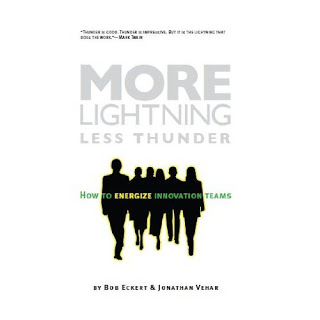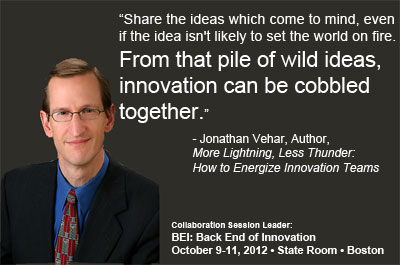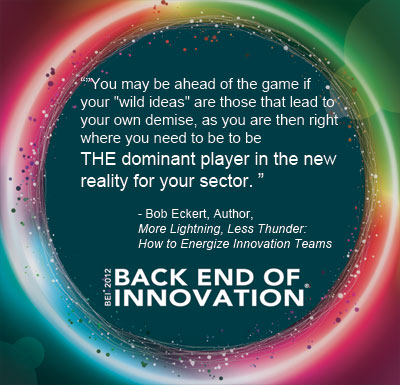Thursday July 26th marked another successful meeting of the innovation book club. Our pick for the month was More Lightning, Less Thunder: How to Energize Innovation Teams by BEI: Back End of Innovation speakers Bob Eckert and Jonathan Vehar. Eckert and Vehar were kind enough to join us for a live Q & A in our LinkedIn group to discuss the book. Read on for some excerpts from the conversation or join our LinkedIn group to read the full thread.
Q. What do you think the biggest challenge is for most leaders in facilitating creative problem solving?
Jonathan Vehar: In our experience, the REAL challenge is not the tools or techniques or even familiarity with process. Rather the challenge is to ensure that people in the room are bringing the right mindset to the process. So many times we teach two people sitting next to each other with the same backgrounds and content knowledge the same thing, and one will be incredibly productive, and the other not at all. What's the difference? The former is accessing their creative mindset and the other is self-editing.
The challenge of the mindset is to help people get past the self-editing mode, which is what we were getting at with the book...starting by helping people be humble enough to "let it all hang out" and share the ideas which come to mind, even if the idea isn't likely to set the world on fire. From that pile of wild ideas, innovation can be cobbled together.
Q. What's one simple step an innovation team leader could take to begin to improve productivity?
Bob Eckert: The real tool that we see people use to great effect is "Praise First, POINt" on pages 52 & 138 of the book. The idea is to first look for what you like in your people's ideas before you look for the danger. It precipitates an entirely different social dynamic as well as different cognition and neurology.
Jonathan Vehar: Bob's answer is completely wrong! Just kidding.
That'd be my first answer as well. One of the objections we frequently hear is, "I don't have time to treat every new idea with a POINt." Keep in mind that POINt needs to be used strategically if you can't use it all the time. POINt becomes an investment in the learning and development of your people...when you take the time to provide that feedback, you're educating yourself on the strength of their idea, and you're helping them to see the concept from YOUR perspective, and in fact educating them. It's a great tool for leader development!
Q. Do you have any stories to illustrate the point that you could share with us?
Bob Eckert: An example of POINt: Recently the Marketing VP of a polymer company has strengthened his reputation and effectiveness with his direct reports as being an "Innovation supporter" by consciously shifting to use of a POINt method in his governance meetings. And we're seeing some much more effective marketing strategies as a result.
Jonathan Vehar: Story of the mindset piece is that whenever we're working with a group to facilitate creative problem solving, we always include a warm-up activity to start to shut down the self-editing...it becomes a teaching opportunity around humility. In the past when I've tried to short-cut that process, using the same tools with the same groups, their productivity is severely hampered! Working on the mindset gets groups productive and creative much faster.
Jonathan Vehar: Another POINt story: An international consumer products company required a group of plant managers to attend a two-day creativity training. After the first day, the participants were given homework: to apply POINt to a work situation before coming to class the next morning. One seasoned plant manager shook her head saying, 'I am not paid to be creative. My job is to run the plant efficiently and keep my workers safe.' She went on, 'I don't like new ideas. It's just more work for me.' But she dutifully took on the homework assignment, and called a worker who was always offering new ideas. During their conversation, the plant manager forced herself to first reflect the positive aspects of the worker's new idea and articulate what positive outcomes might happen if the idea was implemented. The next morning, she reported back to the class. 'That idea is going to save my plant $5000 a week!' She further admitted that if she hadn't used POINt, she would never have had the patience to hear the idea through.
Jonathan Vehar: In another application of POINt, a peer in a meeting ' not a manager or facilitator ' shifted the way a group was evaluating ideas worth millions of dollars. A large pharmaceutical company created a governance committee to evaluate proposals from teams challenged to look for ways to speed both drug development or promising compounds and the decisions to stop development earlier on dead-end projects. A member of the committee noticed that his peers on the governance committee were reacting to each proposal by looking for what was wrong or weak with the idea. Finally, after noticing this pattern among his team members, he made a subtle intervention by asking the team to first look for the pluses. His peers agreed, and rather than killing the idea, worked through a process of searching for pluses, then opportunities and next identified issues, before turning it back to the team to fix the issues and then implement the solution. The idea was one that could save three days on drug development for any drug that made it to the three year mark in development, which equates to about $3 million on each drug in development. One person interviewed said that without the use of the Praise First: POINt technique, this solution was headed where all the other ideas headed: a binder on the shelf never to be implemented.
Bob Eckert: It continues to please, amaze and humble me that some of the most useful and value creating ideas that are created in our sessions come from what initially sounded off the wall and undo-able. At on large Fortune 500 component manufacturing company, someone recently threw out the idea of building products that needed NONE of the components they sell. To create a technology that made their business obsolete. Everyone chuckled. In fact, an incredible patent came out of that which has the likelihood of revolutionizing their sector.
Bob Eckert: Just this morning, speaking with a CEO in the biotechnology sector, he said "I think all business must die eventually" thinking about my last comment, you may be ahead of the game if your "wild ideas" are those that lead to your own demise, as you are then right where you need to be to be THE dominant player in the new reality for your sector.
Read the rest of the conversation and add your comments on LinkedIn here.
Want to hear more from Bob Eckert and Jonathan Vehar? Register for BEI: Back End of Innovation as a reader of this blog & save 15% off the standard registration link, use code BEI12BLOG.
Register:
Online: http://bit.ly/Mtylno
Email: register@iirusa.com
Phone: 888.670.8200



